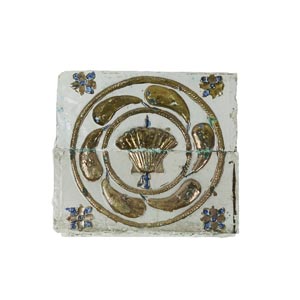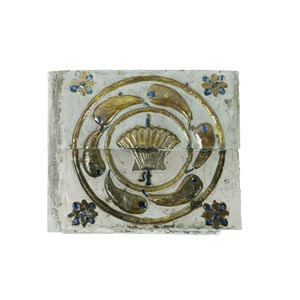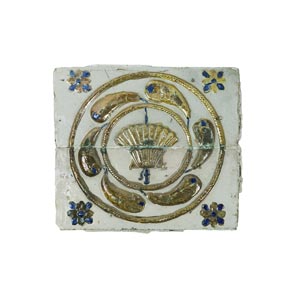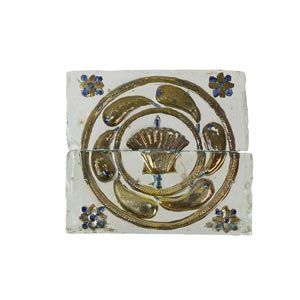
- Home
- Аукционы открытые
-
Аукционы закрытые
- Coins & Medals
- Philately
- Antiquities
- Old Masters
- Jewellery, Silver, Watches
- Ancient and Modern Glyptic
- Ancient Porcelains and Ceramics
- Antiques
- Modern & Contemporary Art
- 20th Century Design and Decorative Arts
- Prints and Multiples
- Asian and Tribal Art
- Photography
- Medieval Art
- Ancient Frames
- Fashion, Textiles & Luxury
- Books, Autographs and Memorabilia
- Wines and spirits
- Oddities, Curiosities & Wonders
- Info
- Live Auction
- Home
- Auction 32
- 20 Frieze of wall tiles. VALENCIA (Manises or Gandia); late ...
Лот 20 - Auction 32
Описание
VALENCIA (Manises or Gandia); late 15th – early 16th century.Portion of frieze comprising fourteen horizontal rectangles designed to be set two by two to form the pattern, and two bands of rectangles to close the composition's two long sides.
Majolica painted in blue and burnished gold lustre; in one of the rectangles, spots of green, possibly a result of dripping from another majolica during firing.
Front: decoration in relief. The recurrent decorative motif inside the frieze, which is obtained by joining two tiles, presents: four rosettes at the sides: a band with chevrons in two ribbed circles in the centre; an umbraculum in the centre; and a small cruciform mark – possibly the potter's signature – at the top of one of the tiles.
Back: unadorned; a black triangle made up of three fleur-de-lys is painted on the tile with a cruciform mark on the front.
In the vertical rectangles: polychrome braid.
Interpreting the emblems: umbraculum, a bishop's and cardinal's privilege and the emblem of the basilicas in Rome; three fleur-de-lys, emblem of the kings of France in honour of the Most Holy Trinity after 1376.
Each group of two tiles: 26.5 x 31 cm.; vertical rectangles: 9 x 4.5 cm. each. Condition: discrete; a few of the tiles still bear slight traces of where they were once glued to masonry.
Exhibitions: Rome, Biblioteca Casanatense, Monumental Hall, “Nymphilexis. Printed Manuscripts, Coins, Medals, Ceramics”, Exhibition 7 April – 30 May 2005.
Bibliography: Gardelli 2005, pp. 302 - 303.This series of tiles belonged to a wall frieze, as we can tell from the complete absence of any sign of their ever having been trodden upon. The chevron decoration and the use of burnished gold lustre in relief are typical features of gilded ceramics manufactured in Valencia from the 15th to the 17th century and beyond. Yet the umbraculum in the centre of the decorative motif – a bishop's and cardinal's emblem but also a motif found on numerous Roman coats-of-arms – takes us to Rome, and more precisely to the pontificate of the Spanish Pope Alexander VI Borgia, a time when these majolicas, commissioned in Spain, were the height of fashion, An important clue in helping us to identify the frieze's original setting is undoubtedly the motif with three fleurs-de-lys impressed on the back of one of them. The three fleus-de-lys, the emblem of the royal house of France, point to the construction of the French church of Trinità dei Monti, begun by Louis XII in 1502 and completed in 1519. It is highly likely that the frieze, commissioned in Manises or Gandia where the best lustre majolica was manufactured, originally formed part of the building's interior decoration.
Используйте форму для регистрации или введите логин в правой части формы.
За дополнительной информацией обращайтесь info@bertolamifineart.com
 Политика использования файлов cookie
Политика использования файлов cookie
Этот сайт использует файлы cookie для улучшения взаимодействия с пользователем и сбора информации об использовании сайта. Существуют также файлы cookie, которые можно использовать для выбора персонализированной рекламы и рекламного контента. Вы можете ознакомиться с нашей политикой использования файлов cookie, принять все файлы cookie и продолжить просмотра, нажав "Принять" или измените свой выбор, нажав "Настроить".
Политика использования файлов cookie
Файлы cookie
Чтобы этот сайт работал должным образом, мы иногда устанавливаем на ваше устройство небольшие файлы данных, называемые " cookie ". Большинство крупных сайтов делают то же самое.
Что такое файлы cookie?
Файл cookie - это небольшой текстовый файл, который веб-сайты сохраняют на вашем компьютере или мобильном устройстве во время их посещения. Благодаря файлам cookie сайт запоминает ваши действия и предпочтения (например, логин, язык, размер шрифта и другие параметры отображения), чтобы вам не приходилось повторно вводить их, когда вы возвращаетесь на сайт или переходите с одной страницы на другую.
Как мы используем файлы cookie?
Сторонние файлы cookie
Google Analytics
Этот сайт использует Google Analytics для сбора информации об использовании пользователями его веб-сайта. Google Analytics генерирует статистическую и другую информацию с помощью файлов cookie, хранящихся на компьютерах пользователей. Информация, полученная в отношении нашего веб-сайта, используется для составления отчетов об использовании веб-сайтов. Google будет хранить и использовать эту информацию. Политика конфиденциальности Google доступна по следующему адресу: https://policies.google.com/privacy .
Для работы сайта не обязательно включать файлы cookie, но это улучшает навигацию. Можно удалить или заблокировать файлы cookie, но в этом случае некоторые функции сайта могут работать некорректно.Информация о файлах cookie не используется для идентификации пользователей, и данные навигации всегда находятся под нашим контролем. Эти файлы cookie используются исключительно для целей, описанных здесь.
Как контролировать и изменять файлы cookie?
Вы можете изменить или отозвать свое согласие в любое время в декларации файлов cookie на наш сайт.
Политика конфиденциальности
Узнайте больше о том, кто мы такие, как вы можете связаться с нами и как мы обрабатываем личные данные, в нашем политика конфиденциальности .
Необходимые файлы cookie помогают сделать веб-сайт пригодным для использования за счет включения основных функций, таких как навигация по страницам и доступ к защищенным областям сайта. Веб-сайт не может нормально функционировать без этих файлов cookie.
| Имя | Поставщик | Цель | Срок действия |
|---|---|---|---|
| cookieConsent | Bid Inside | Сохраняет статус согласия пользователя на cookie для текущего домена | 6 месяцев |
| PHPSESSID | Bid Inside | Сохранять статус пользователя на разных страницах сайта. | Когда сеанс просмотра заканчивается |
| f_display | Bid Inside | Файлы cookie f_display запоминают режим отображения, выбранный пользователем на страницах, где есть списки. | Когда сеанс просмотра заканчивается |
| f_page | Bid Inside | Файлы cookie f_page хранят страницу, просмотренную пользователем, на страницах, где есть списки. | Когда сеанс просмотра заканчивается |
| f_rec_page | Bid Inside | Файлы cookie f_rec_page хранят количество элементов, которые должны отображаться на странице, выбранной пользователем на страницах, на которых есть списки. | Когда сеанс просмотра заканчивается |
| f_order_by | Bid Inside | Файлы cookie f_order_by хранят выбранный пользователем параметр сортировки на страницах, где есть списки. | Когда сеанс просмотра заканчивается |
| f_order_dir | Bid Inside | Файлы cookie f_order_dir хранят направление упорядочивания, выбранное пользователем на страницах, где есть списки. | Когда сеанс просмотра заканчивается |
| watch_list_show_imgs | Bid Inside | Файл cookie watch_list_show_imgs хранит выбор пользователя, отображать или скрывать изображения лотов на странице списка наблюдения | Когда сеанс просмотра заканчивается |
| selected_voice | Bid Inside | В файле cookie selected_voice хранится голос, выбранный пользователем для синтеза речи, присутствующий на живом аукционе | 1 Месяц |
| include_autobids | Bid Inside | Файл cookie include_autobids сохраняет выбор пользователя — показывать или скрывать свои auto-bid на странице «Ваши ставки». | 6 месяцев |
Аналитические файлы cookie помогают понять, как посетители взаимодействуют с веб-сайтом, собирая и передавая статистическую информацию контроллеру данных.
| Имя | Поставщик | Цель | Срок действия |
|---|---|---|---|
| _ga | Зарегистрируйте уникальный идентификатор, используемый для генерации статистических данных о том, как посетитель использует веб-сайт. | 2 года | |
| _gat_gtag | Используется Google Analytics для ограничения частоты запросов | 1 день | |
| _gat | Используется Google Analytics для ограничения частоты запросов | 1 день | |
| _gid | Зарегистрируйте уникальный идентификатор, используемый для генерации статистических данных о том, как посетитель использует веб-сайт. | 1 день | |
| __utma | Bid Inside | Используется для различения пользователей и сеансов. Файл cookie создается, когда библиотека javascript выполняется, а существующие файлы cookie __utma не существуют. Файл cookie обновляется каждый раз, когда данные отправляются в Google Analytics. | 2 годы |
| __utmt | Bid Inside | Используется для ограничения скорости запросов. | 10 минут |
| __utmb | Bid Inside | Используется для определения новых сеансов / посещений. Файл cookie создается, когда библиотека javascript выполняется, а существующие файлы cookie __utmb не существуют. Файл cookie обновляется каждый раз, когда данные отправляются в Google Analytics. | 30 минут |
| __utmc | Bid Inside | Не используется в ga.js. Набор для взаимодействия с urchin.js. Исторически этот файл cookie работал вместе с файлом cookie __utmb, чтобы определить, был ли пользователь в новом сеансе / посещении. | Когда сеанс просмотра заканчивается |
| __utmz | Bid Inside | Сохраняет источник трафика или кампанию, объясняющую, как пользователь попал на ваш сайт. Файл cookie создается при запуске библиотеки javascript и обновляется каждый раз, когда данные отправляются в Google Analytics. | 6 месяцы |
| __utmv | Bid Inside | Используется для хранения данных пользовательских переменных на уровне посетителя. Этот файл cookie создается, когда разработчик использует метод _setCustomVar с настраиваемой переменной уровня посетителя. Этот файл cookie также использовался для устаревшего метода _setVar. Файл cookie обновляется каждый раз, когда данные отправляются в Google Analytics. | 2 годы |
Предпочтительные / технические файлы cookie позволяют веб-сайту запоминать информацию, которая влияет на то, как сайт ведет себя или представляет себя, например, ваш предпочтительный язык или регион, в котором вы находитесь.
Мы не используем файлы cookie этого типа.Профилирующие файлы cookie используются в маркетинговых целях для отслеживания посетителей веб-сайта. Их цель - отображать релевантную и привлекательную рекламу для отдельного пользователя.
| Имя | Поставщик | Цель | Срок действия |
|---|---|---|---|
| _fbp | 6 months | ||
Неклассифицированные файлы cookie - это файлы cookie, которые классифицируются вместе с отдельными поставщиками файлов cookie.
Мы не используем файлы cookie этого типа.










 21
21